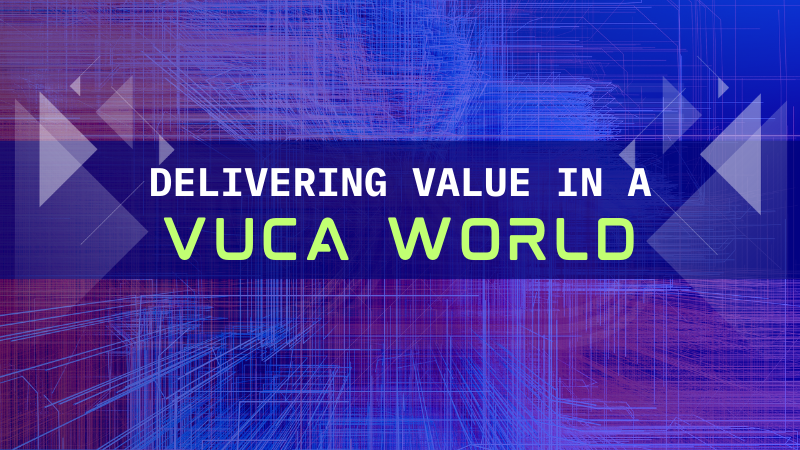
by DharamCW | Nov 30, 2024 | Project Management
Introduction: Navigating the VUCA Landscape
As the world is moving towards hyper-active technological disruption, its high time for Project Managers to learn effective ways to deliver value in a VUCA environment. There are plethora of examples demystifying the concept of VUCA. But very few revitalizing its impact on project management and value delivery. This article is framed to have a clear picture on how it works, the balancing act, mindset and delivering value from a Project, Program, Portfolio Manager Perceptive.
Understanding VUCA
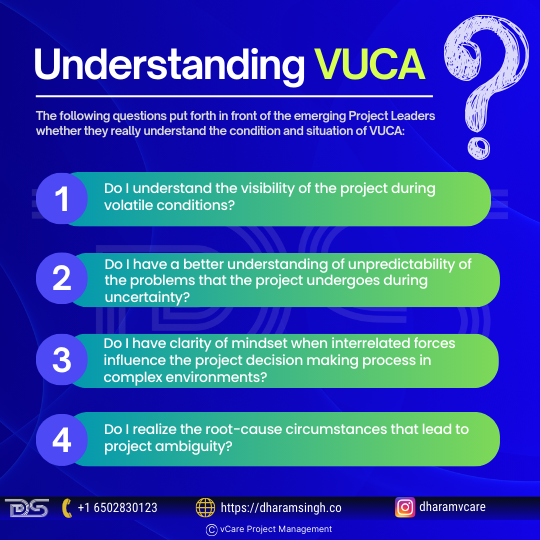
Understanding VUCA
Let’s get started with what VUCA stand for – Volatility, Uncertainty, Complexity, Ambiguity. It was formally developed by US Army War College in 1987 after the Cold War, to reflect how to oversee complex multilateral world situations. The acronym VUCA is derived from the leadership theories of Warren Bennis and Burt Nanus. Delivering value have direct correlation with the economic equation of the countries in which projects involved. The dynamics of environment changes impact the project success direction. Those adversaries needed to handle with focus mind, determination, perseverance by the Project Leaders. The following questions put forth in front of the emerging Project Leaders whether they really understand the condition and situation of VUCA:
- Do I understand the visibility of the project during volatile conditions?
- Do I have a better understanding of unpredictability of the problems that the project undergoes during uncertainty?
- Do I have clarity of mindset when interrelated forces influence the project decision making process in complex environments?
- Do I realise the root-cause circumstances that lead to project ambiguity?
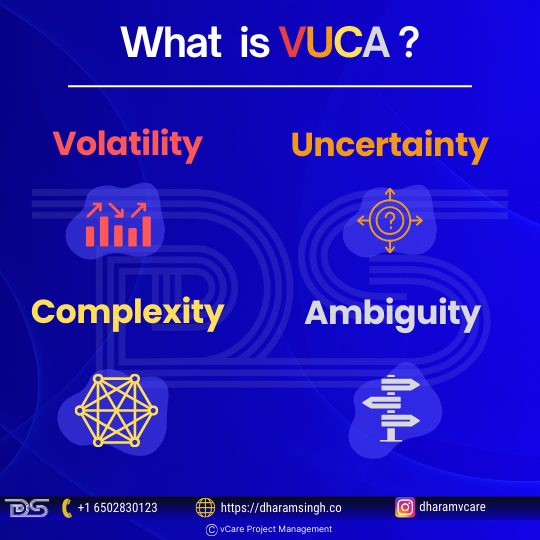
What is VUCA?
All these four questions streamline Project Manager to understand his unknowns – unknowns and better deal with this environment. Let us have a briefing on VUCA,
- Volatility: The rate of change or churn in business environment which directly affects the daily operations of the project. The Project Managers will always be in bed of thorns to mitigate the volatile situation and try to settle into normal rhythm.
- Uncertainty: The world is full of surprises when delivering value, that too for project managers it will be high potential for surprise due to lack of predictability in an uncertain environment. They need to have good assumptions capabilities to plan for future uncertainties.
- Complexity: Diverse global supply chain gets impacted directly with geopolitical, economical, dynamics of industries add complexities to the project success. Better observing of interrelated forces is need of the hour for the Project Managers.
- Ambiguity: The common misunderstandings and unclear realities cause project delays affecting the value delivery process. It naturally makes it difficult to construct risk mitigation plans.
The Impact on Project Management in VUCA World
VUCA influences project, program, and portfolio management, particularly in high-stakes environments. Whether it is a good sign or bad sign depends on the mindset of the Project Manager. Can we eliminate VUCA is a big question mark among the Project Leaders. We need collective responsibility when handling VUCA and one step at a time approach. Agile approach is good to proceed with but not the absolute one to stick on. As a project manager we need to dynamic and adapt to the changing environment and be hybrid to mitigate the risks and challenges VUCA environment brings into the project.
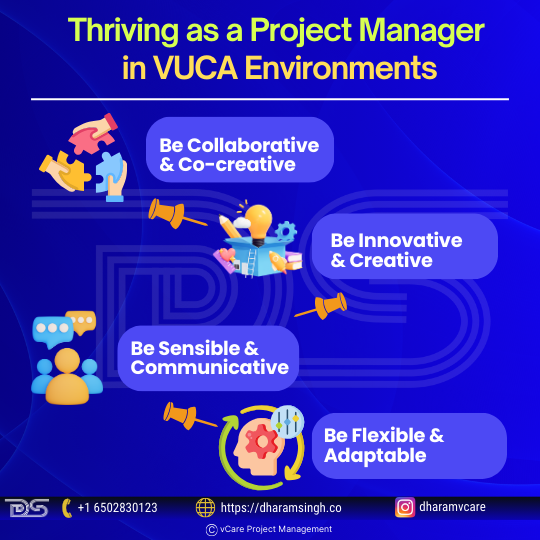
Thriving as a Project Manager in VUCA environment
Some tips for Project Manager to thrive in such environments:
Be Collaborative & Co-creative: Project Managers need to have meaningful collaborations with their team members. Their options, problem solving instance should be appreciated and involved in the decision-making process. Positive collaboration leads to positive co-creation combining for best value-based project delivery.
Be Innovative & Creative: Developing child-like mentality with outlook of creativity Project Managers can do wonders with innovations in their projects. Both have close twin knots, losing one will automatically supress the other.
Be sensible & communicative: Here we trigger the sensibility in voicing with clarity to your entire stakeholders – sponsors, team members, top management, external and internal state actors. Project Manager’s voice should be uniform throughout the top and bottom of the pyramid. This helps to face disruption with united response.
Be flexible & adaptable: Project Managers need to be flexible as grass, dancing to changes in project environment in the VUCA world. Adaption is a must from all levels which need patience and fair amount of training from the organization.
VUCA environment should be seen an opportunity rather than a challenge for organizations to thrive. These tips will be helpful for Project Managers to position themselves with resilience in such environments.
Strategic Leadership in a VUCA World
According to Wikipedia, Andrew Porteous quotes “Failure in itself may not be a catastrophe. Still, failure to learn from failure is.” Project leaders must understand there is no fool proof techniques to address VUCA environments. The only solution is fail fast, fail safe and learn from failures. While this mindset is difficult to grasp but have a sense of community to better positive predictions. Both introspections and evaluations needed to navigate and thrive in such environments. Connecting the dots between strategy and delivery results in better project outcomes. The Project Leaders performs the balancing act between the two. How well they balance need greater amount of critical analysis.
Cultivating Versatility
Developing adaptable leadership styles to manage unpredictable challenges aids the Project Leaders to manoeuvre better reliable strategies for projects. A pragmatic approach of leadership will enhance the decision-making process. The project duress created from the realms of political, economic, technical, social, market, nature calamities like Covid-pandemic gives a moral responsibility for leaders to rethink their leadership style. The harder problems of technological imbalances due to Artificial Intelligence (AI) making it difficult to craft strategies.
According to MIT Sloan Management Review, change management and emotional intelligence top the list of skills leaders to focus to steer the teams for project success. There is a serious limitation and notion of inadequate performance of leadership in these skills. So, organizations can address such extreme mishaps in their leaders by developing versatile leadership. Versatile leadership is forgoing continuous adjustments to their behaviour, meticulously applying right approach, to the right degree, for the circumstances at hand.
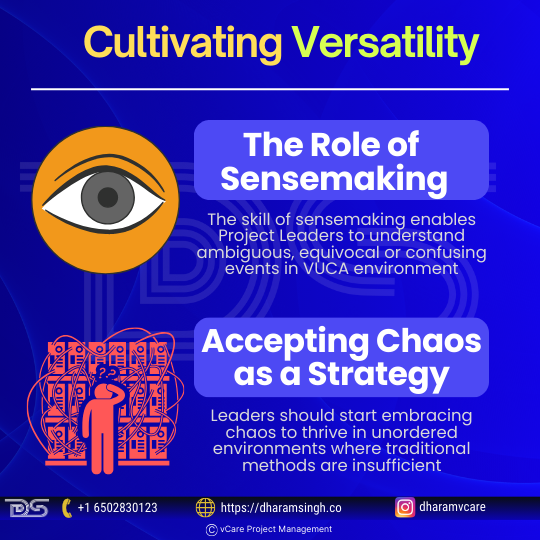
Cultivating Versatility
The Versatile Leader mind works in the absence of imbalance, fostering clear vision to handle tough environments. F. Scott Fitzgerld, in his 1936 essay “The Crack-Up,” quotes “the test of a first-rate intelligence is the ability to hold two opposed ideas in the mind at the same time, and still retain the ability to function.” This is the major challenge a Versatile Leader should pass by adoring wide and flexible range of behaviours
- The Role of Sensemaking: The root causes of imbalance is due to strategic-operational dualities faced by the leaders. The skill of sensemaking enables Project Leaders to understand ambiguous, equivocal or confusing events in VUCA environment. Sensemaking techniques aids for interpreting complex situations and making informed decisions in shifting markets. These capabilities help leaders to drive organizations forward, by having a clear 360-degree vision on environment they work upon.
- Accepting Chaos as a Strategy: Leaders should start embracing chaos to thrive in unordered environments where traditional methods are insufficient. From exponentially increasing technological advancements, economic and political aftershocks, disruptions like these have significant impact on the global supply chain. A well-engineered leadership mind will craft chaos as a strategy framework to streamline business operations for smooth project handling.
Balancing Speed with Thoughtfulness
In the fast-paced rapidly changing environment balancing speed with thoughtfulness is a daunting task for Project Managers. Ambitious targets in short durations leads to disrupt project progress leading to project delays and later project failures. Setting vibrant goals dominate the modern workplace. The thoughtfulness of leaders to change their conventional wisdom towards goal setting is key.
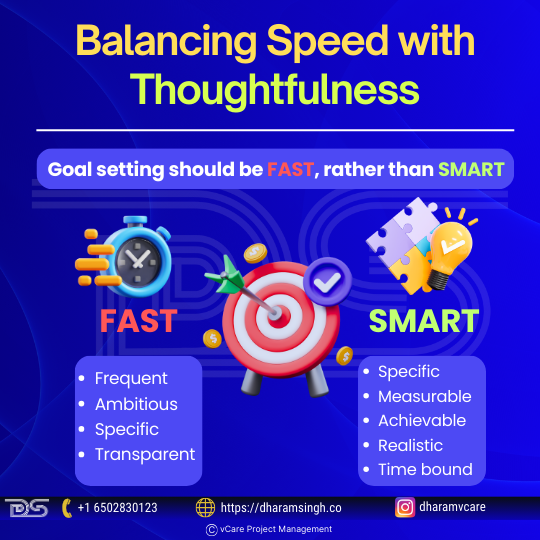
Balancing Speed with Thoughtfulness
As goals drives strategic execution of value delivery, interdependencies of silos plays a vital role for balancing the delivery value chain. A word of caution should always be there in mind of Project Managers when balancing speed with thoughtfulness. Goal setting should be FAST (frequent, ambitious, specific, and transparent) rather than SMART (specific, measurable, achievable, realistic, and time-bound) in VUCA environment.
The Danger of Speed-Centric Goals
Creating value quickly is the new paradigm shift, organizations seek to transform all or part of their businesses. Speed-centric goals lead to high performance of trajectory for the organization but do have the adversity of total failure push back. Proper prioritization of risks is needed to achieve rapid time-bound outcomes. The Project Leader should construct a rigorous cluster of plans in short-duration sprints to overcome potential long-term consequences with thoughtful value delivery.
Prudent Risk Management vs. Aggressive Growth
Too match the pace of market demands in the digital age, the pivot of risk-taking is quintessential for Project Leaders safeguard the organizational immune system. In today’s scenario avoiding risks is not a priority, leaders need to be proactively involved in identifying, evaluating, and strategizing risk mitigation plans. Risk-taking foster growth and innovation in VUCA world. Leaders should sharpen their risk management capabilities and be prudent. A prudent risk taker maintains calmness during uncertain times and able to show resilience with sound and rational decision-making. Rather than focusing on aggressive growth, Project Leaders need to navigate a path to smart growth. Organization’s reap multiple benefits by having “The Growth Corridor” balancing between minimum growth and maximum growth to drive innovation and survival at the marketplace.
Enhancing Communication and Team Adaptability
Organization’s stability dismantled when fear of disorders overlooks in the mind of employees from the top to bottom management. To overcome stagnation and steer through treacherous waters of VUCA, the Leader should communicate effectively. VUCA communication leans towards sleek perfection, setting clear direction and rallying behind employees’ voice. Leaders unify team adaptability call to action of cohesive strength to face the battle fluctuations and achieve value delivery.
Clear Communication in a VUCA Environment
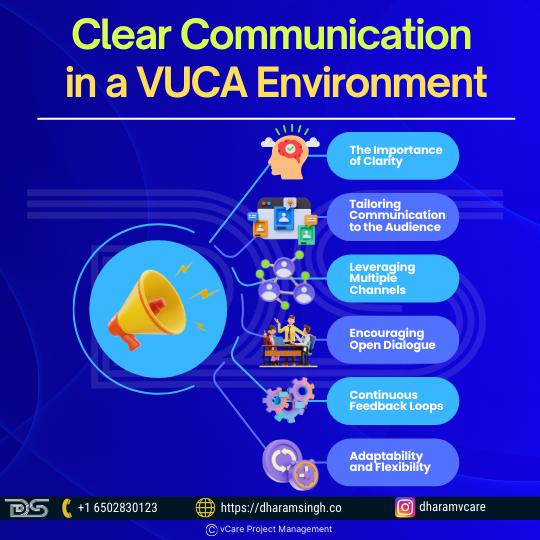
Clear Communication in a VUCA Environment
Effective communication is crucial yet challenging in VUCA world. Shifting dynamics of the workplace needs strategies not only communicate information clearly but make sure to reduce friction across the realms of the various verticals and horizontal in the organization. Let us walkthrough some of the effective VUCA Communication tips:
- The Importance of Clarity: Clarity in communication helps reduces misunderstandings, align team efforts, and reduce the friction that often arises in high-stakes, rapidly changing environments.
- Tailoring Communication to the Audience: Understanding the audience’s pulses to streamline communication.
- Leveraging Multiple Channels: Avoid bottlenecks and constraints by leveraging multiple channel communication.
- Encouraging Open Dialogue: Open dialogue fosters a culture of sensibility leading to more transparency, trust, and accountability, which are vital in uncertain environments.
- Continuous Feedback Loops: Creating continuous feedback loops allows teams to quickly adjust their communication practices as the environment changes.
- Adaptability and Flexibility: Both adaptability and flexibility not only improve clarity but also helps to maintain morale and cohesion among teams facing uncertainty.
Continuous Improvement of Skills
Keep pace with the evolving demands of a VUCA world, creating a learning organization is needed. It should need to be embedded into organizational culture fostering continuous improvement. According to Klaus Schwab in The Fourth Industrial Revolution, the integration of advanced technologies like Artificial Intelligence (AI) and Internet of Things (IoT) into everyday business processes means that the skills required today may be obsolete tomorrow. Continuous learning ensures that Project Managers can adapt to these rapid changing shifts, maintaining their relevance and effectiveness in VUCA world.
Conclusion: Thriving Beyond Boundaries
Embedding resilience into the Project Manager to thrive in VUCA world is a never-ending experience and experiment that organization keeps on retrospect for betterment. Delivering value in an increasingly boundaryless world, creating positive hopes of survival lies in the hand of versatile leaders. Such architecting leaders able to cultivate better systems, structures, culture, possibilities, and autonomous decision making to teams, in chaos.
The Project Leaders should develop: sensemaking with life-long learning, balance speed with thoughtfulness, managing risk with growth mindset, prioritize communication, skill development, foster a culture of continuous improvement, and embrace versatility, to deliver value in VUCA world.
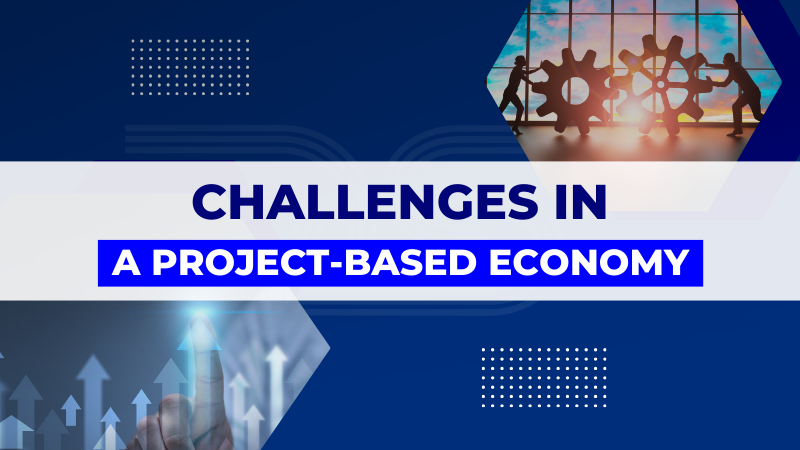
by DharamCW | Jun 11, 2024 | General
People in the Project Economy have all the skills and capabilities required to turn ideas into reality, regardless of the type of project they are working on. It is the process by which organizations provide value to stakeholders by completing projects, delivering products, and aligning with value streams.
Project-based work has well-defined goals, milestones, deliverables, and a start and end date. Projects can last hours, months, or years, depending on the project and business needs. However, the work is focused on business needs and objectives rather than specific roles.
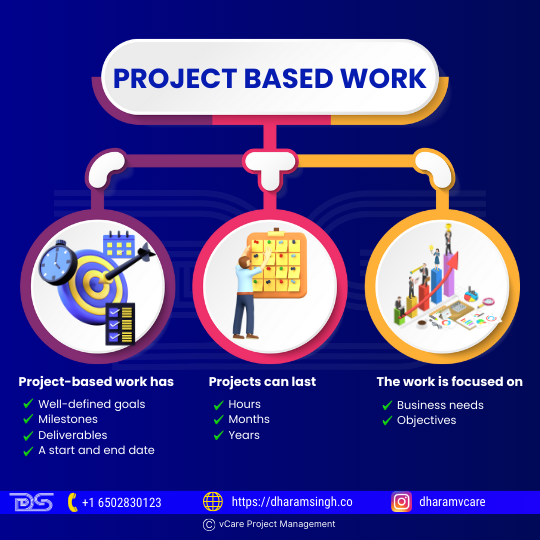
Project Based Work
Business leaders always want their teams to be agile and nimble. Adopting a project-based work mindset can help them achieve their goals. In addition, according to a recent MIT and Deloitte report, executives are increasingly viewing their workforce as an ecosystem, drawing on the diverse skill sets of their full-time employees and freelancers to meet business challenges.
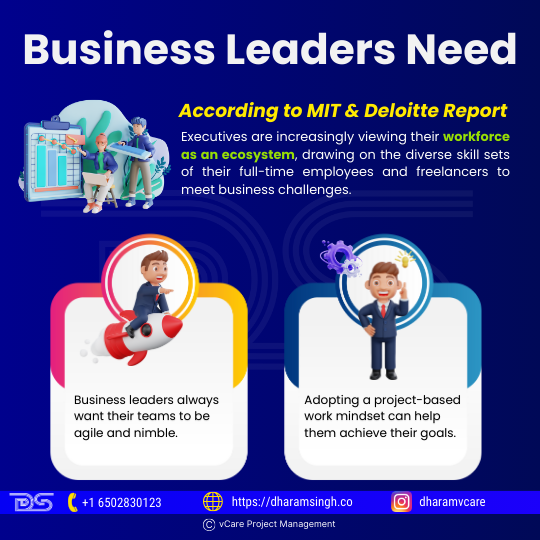
Business Leaders Need
The Project Economy Has Arrived
The Harvard Business Review Project Management Handbook (2021) by Antonio Nieto-Rodriguez states that:
- By 2027, nearly 88 million people worldwide are expected to be employed in project management, and the value of project-oriented economic activity is expected to reach $20 trillion.
- However, research shows that only 35% of global projects are successful, implying that project professionals waste time, money, and opportunity.
- To capitalize on the new project economy, businesses must adopt a project-driven organizational structure to ensure executives can sponsor projects and train managers in modern project management.
The Rise of the Project Economy
Berkley’s guide states that the rise of the Project Economy will play an essential role in the Future of Work. The following statistics from the below-mentioned survey make this statement more accurate:
- Almost 80% of executives believe the future of work will be project-based rather than role-based.
- More than 85% of all highly skilled independent contractors work in the Project Economy.
- According to the PMI, project-based economic activity will increase by 68 percent, from $12 trillion in 2013 to $20.2 trillion in 2027. Employers will require 87.7 million PM-related specialists by 2027.
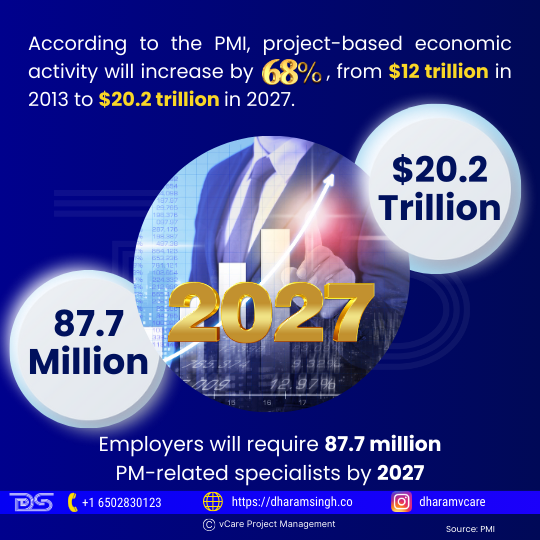
PMI Report
- 89% have at least one project management office (PMO), and 50% have multiple.
- Project work is expected to increase by 68% in the future, according to The State of Project Management report by Wellingtone.
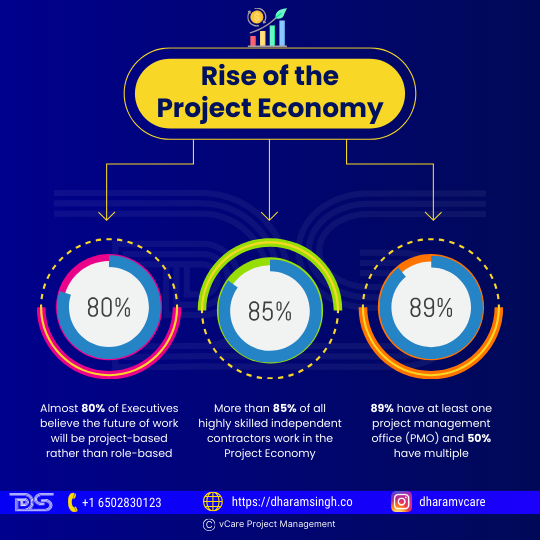
Rise of the Project Economy
Challenges for the whole organization
The world is changing faster than ever, and businesses need help keeping up. However, savvy companies understand that the solution lies in developing and leveraging their people’s most valuable asset.
According to Global Talent Trends 2022 studies, workers are more stressed than ever. Eighty-one percent report being at risk of burnout, and one in five blame working for a company whose values do not align with theirs.
Human resource and project managers face many challenges in the whole organization.
- Close Skill Gap
Planning and managing long-term skill development will become more important as people lead longer, more diverse careers. Digital skills are now expected, and knowledge of business processes and related concepts is considered a core competency in every worker’s skill set.
Analytical and critical thinking skills have progressed from the exception to the norm, while interpersonal and leadership abilities are more valued than ever. Yet, many businesses face crucial skill shortages, particularly in retail, construction, real estate, manufacturing, education, medical and health services. According to McKinsey, 87 percent of executives report or expect skills gap challenges in the next few years.
- Initiatives to improve hiring
Hiring talented, qualified people has become critical to business success in a world of labor shortages and job-hopping. But it takes work.
- According to Josh Bersin’s study, 74 percent of businesses in the United States underperform when hiring, and only 60 percent of newly created jobs are filled.
- Businesses are attempting to attract not only talented but also diverse employees: The State of DEI Efforts report states that Finding various candidates with appropriate qualifications is the most difficult challenge for 43 percent of respondents.
- Also, Glassdoor’s Diversity and Inclusion Workplace Survey states that 76 percent of job seekers and employees value a diverse workforce when evaluating companies and job offers.
- Leadership development
Living in a volatile, uncertain, complex, and ambiguous (VUCA) world has become the norm. Influential leaders must be agile, constantly reevaluate and iterate their leadership practices, and strongly desire to build resilience for the future.
Organizations must adapt to new levels of complexity and ambiguity due to the COVID-19 pandemic’s disruption of the global economy and traditional modes of operation. The recovery from COVID-19 and the long-term impact of its disruption remain unknown. However, many organizations plan to meet their strategic goals and objectives as things begin normalizing. They must be especially cautious in the VUCA world.
VUCA: Companies and managers must embrace versatility, agility, and discomfort to progress. Covid-19 was the year of the phygital revolution – the physical, digital, and online-offline workplace convergence. In such a VUCA environment, managers and companies must be versatile, uncomfortable, collaborative, and agile to progress in a Phygital world. Therefore, every company and leader must be skilled in being versatile, uncomfortable, collaborative, and agile.
- Workforce retention
The ‘Great Resignation’ has resulted in historic numbers of people quitting their jobs, with the following industries suffering the most:
- Leisure and hospitality
- Trade, transportation, and utilities
- Professional and business services
- Education and health services
- Manufacturing
- Construction
Businesses are grappling with the issue of how to retain employees. One solution is to provide employees with opportunities for learning and skill-based career growth. However, employees see professional development opportunities as the most important way to improve and change the company culture.
- The Workplace Learning 2022 Report states that 46% of L&D leaders said upskilling or reskilling was a top focus area this year; internal mobility, career pathing, and employee retention fell toward the bottom.
- According to The American Upskilling Study 2021 study, 66 percent of workers aged 18-24 ranked upskilling opportunities as the third-most important benefit in evaluating a new job, and 48 percent of workers in the United States would relocate for such opportunities.
- Enterprise agility
To thrive in a highly dynamic world, organizations must quickly adapt to changing technology, markets, and customer needs. Enterprise agility denotes a shift away from traditional hierarchical structures and disconnected teams toward an operating model that optimizes strategy, structures, processes, people, and technology.
Rather than being hindered by the relentless pace of change, agile enterprises are more likely to capitalize on emerging technologies and business trends to differentiate themselves from the competition. However, as per a McKinsey report, two-thirds of businesses say they need to prepare for workforce disruptions brought on by technological and market trends.
- The transformational potential of learning
Employees and organizations are moving together as they navigate the complexities of a rapidly changing world. Workers must embrace a culture of lifelong learning to remain relevant. The benefits for businesses are evident, with skilled workers becoming more agile and motivated. In addition, Upskilling and reskilling can transform society as a whole, allowing under-represented groups to participate in the economy and be more involved.
- Impact of Emerging Technologies
Emerging technologies continue to influence how we live, work, and interact in a world driven by digital solutions. Many technological advancements are beneficial: they increase productivity, make necessary services more accessible, and generally make our lives easier.
Emerging technologies such as artificial intelligence (AI), robotics, the Internet of Things (IoT), blockchain, cybersecurity, and big data can make products and services more widely available, particularly to those currently unable to use them.
Several significant benefits for business processes should also be considered. Businesses already use a variety of digital solutions to attract customers, such as applications and websites. By 2030, approximately 70% of companies worldwide will have adopted at least one type of AI technology, with other emerging technologies being implemented quickly. Thus, technological solutions will continue to automate and innovate our work.
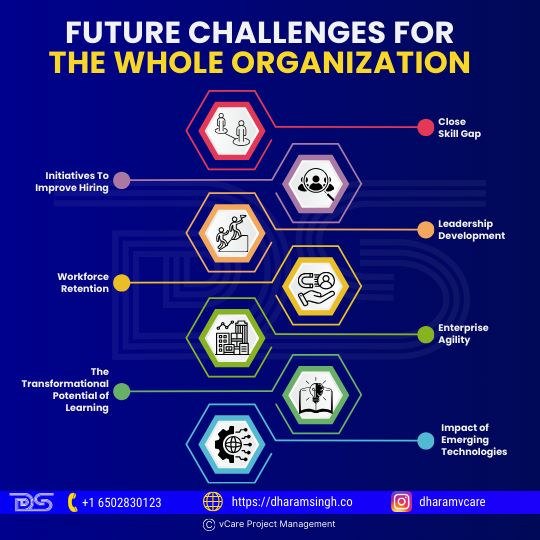
Future Challenges for the Whole Organization
Perspective Competency and Strategic Envisioning
A better approach would be to stop thinking about today’s challenges in terms of ‘project management.’ Instead, we must reframe the question to how we can do our work most efficiently. This also entails abandoning the notion of project management as a technical discipline in favor of viewing it as a collection of skills and disciplines required to complete work today. Christoffer Ellehuus, in the article Succeeding in the Project Economy, outlines four significant components for this phase.
- Strategy
Executing a strategy must be rooted deeply in the organization and must be understood by all. The biggest challenge is selecting the right work and eliminating unnecessary tasks. In addition, identifying opportunities for innovation, growth, and value creation are critical areas for improvement.
- Work
Work completion necessitates action in three areas: process expertise, workflow management, and innovation. The most challenging priority is managing multiple priorities and interrelated work streams. Project management is a skill that should be developed in every sector.
- People
80% of managers see the need to create conditions for leading in an environment of ambiguity. 79% know the challenge of leading through change or transformation as a priority. A significant shift in how leaders approach people management is required to nurture team members and build the capacity to deal with challenges.
- Self
A well-developed ability to manage and improve your capacity is immensely valuable. Therefore, the most urgent focus areas are to build creative, problem-solving, and critical-thinking skills.
Understanding Generation Z in the workplace
A new generation brings a new outlook on work. Generation Z is already an undeniable force in shifting corporate culture. By 2025, Gen Z employees will account for 27% of the workforce, bringing their expectations and values. There may be an area where an existing employee’s opinions, ideas, and working patterns vary. So, there should be an area to bridge the gap between the experienced and Gen Z employees.
Bridging the Gap – Experienced vs. Generation Z
Today, younger generations are entering the workforce. At the same time, older employees remain in the workforce for longer due to economic necessity. In the workplace, the experienced and Generation Z employees may have noticed a few challenges and questions to the management while allocating them a task together:
- Do these coworkers have difficulty conversing with one another?
- Do they appear to have opposing processes and preferences for completing their work?
- Have their differences hampered their ability to generate complementary ideas and collaborate on projects from start to finish?
- Do they find it difficult to relate to customers of different generations and adapt to their expectations?
- Are they having trouble identifying common motivators for their team?
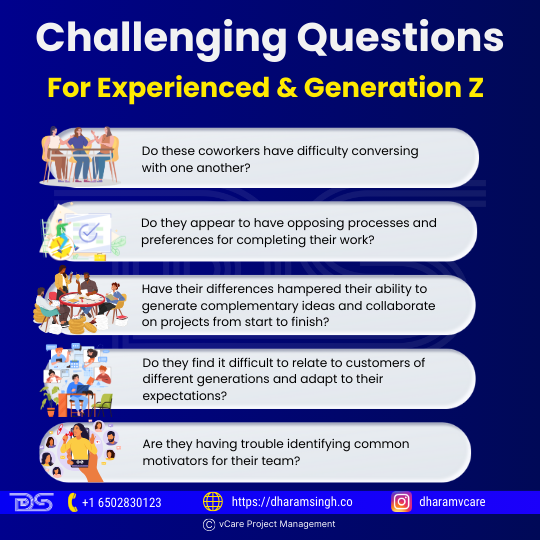
Challenging Questions For Experienced & Generation Z
But it might be better if the experienced employee tries to learn about Gen Z’s as they are thoroughly updated on technologies and adapted to hybrid working culture. Some aspects that may build the bond between experienced and Gen Z employees:
- Gather inputs from each other
- Live the culture
- Create opportunities for face-to-face interaction
- Facilitate frequent peer-to-peer recognition
- Form cross-generational teams
- Implement social technology for building relationships at work
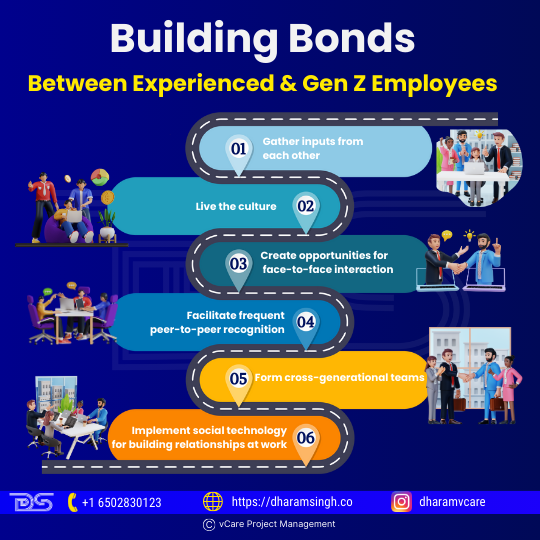
Building Bonds Between Experienced & Gen Z Employees
The Skills Challenges of the Future Workforce
Technology, globalization, demographics, social values, and changing personal expectations of workforce participants are causing a dramatic change in the future of work and the workforce. As per The Future of the Workforce study, there are four significant workforce causes of disruption:
- Demographic upheaval
- Ever-present and changing digital technology
- An accelerated rate of change and business-model innovation
- The rise of a new social contract
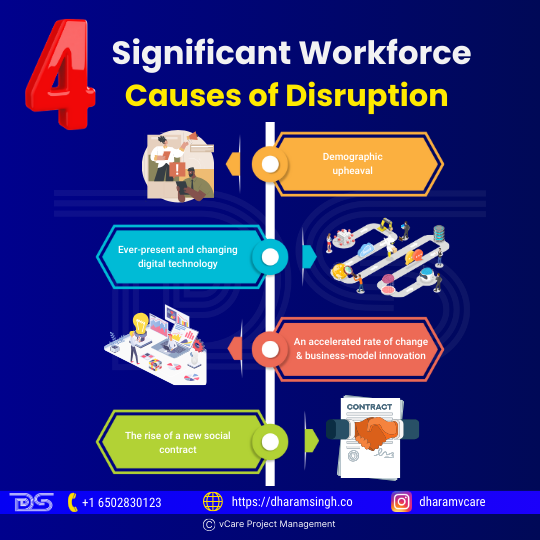
Significant Workforce Causes of Disruption
To survive the hypercompetitive, fast-paced future of work, an organization must be laced with strong interpersonal connections across a diverse workforce. In the aspect of a better workforce in the future, the employees need to necessitate the combination of four key work skills:
- Digital tools and technological abilities
- Good understanding of analytics and data
- Business management abilities
- Design and creative abilities
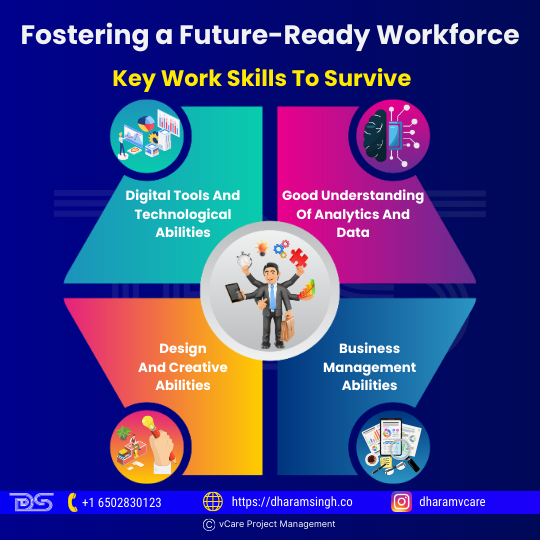
Key Work Skills to Survive
Get adapted to change
The projectification of work has rapidly shifted the nature of most professionals’ work, moving away from routine operations and decisively toward project leadership. In this new world, executives must answer three critical questions.
- Is your organization prepared to thrive in the project-based economy?
- Do professionals in your organization have the necessary adaptive mindset to carry out critical projects?
- Do your project managers have the business skills to prioritize competing workstreams and align with shifting business priorities?
The way forward
Great projects don’t just improve work; they improve the world. Key characteristics that leaders must possess to excel in a project-driven world:
- Project management skills
- Product development and subject matter expertise
- Strategy and business acumen
- Leadership and change management skills
- Agility and adaptability
- Ethics and values
Managers and organizations must become comfortable devising strategies driven by change rather than efficiency to transform themselves and thrive in the new project economy. They must delegate more resources, budgets, and decision-making authority to projects and project teams rather than the traditional departmental hierarchy. They will need to develop project management skills and adopt new technologies. Finally, they must encourage a shift in emphasis away from inputs and outputs and toward outcomes and value.
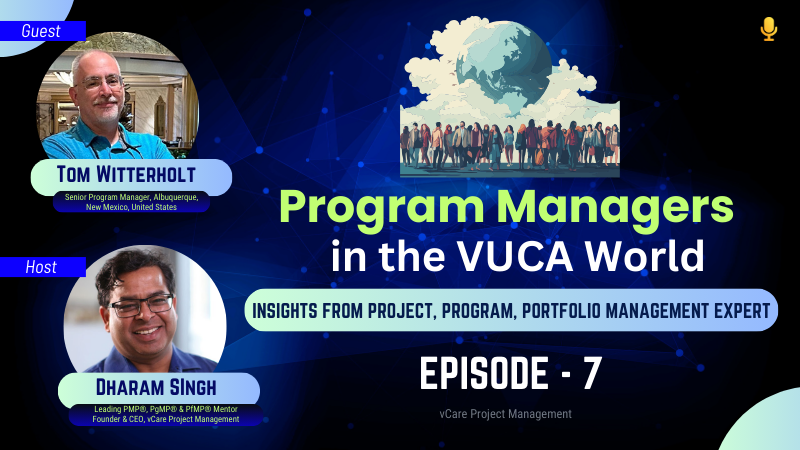





















Are Program Managers ready to accept the challenges and offer solutions to address emerging realities in the VUCA world?
– What is VUCA?
– Navigating Uncertainties
– Upskilling – Today & Future
– Why Program Managers Must Stay Informed
– Stakeholders Communication